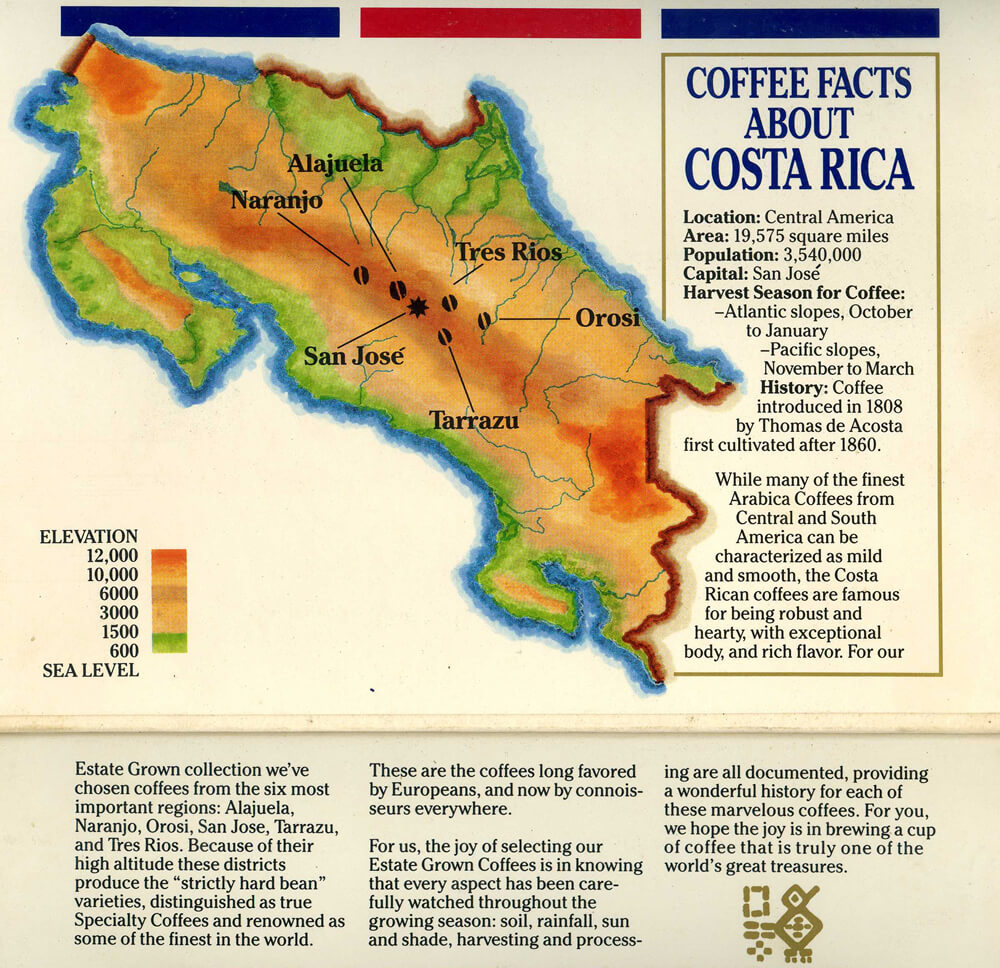
How We Roast The Perfect Coffee
COFFEE'S RICH HISTORY & TRADITION
Coffee is believed to have originated in the central high plateaus of Ethiopian rainforest. Historians trace coffee back for about 1500 years with the Arabs being the first to start cultivating it more than 500 years ago. Coffee was introduced to Europe in the seventh century through Venetian trade with Turkey. Tomas Acosta was the first to introduce coffee to Costa Rica in the early 1800s and the commercial cultivation started in 1860. Today coffee is still an important part of the Costa Rican culture and one of Costa Rica's largest cash crop.
MAP SHOWING THE IMPORTANT COFFEE REGIONS
Costa Rica's gourmet coffee have long been favored by the European coffee lovers for their high acidity, excellent body, and good aroma. From the five most famous coffee regions in Costa Rica we have selected the finest from the Tarrazu, Tres Rios and Alajuela regions. These coffee growing regions are blessed with a perfect combination of rich volcanic soil, location at high altitudes (3900 ft. to 5400 ft.), and a warm climate with the right amount of humidity.
Click here for full size map
ON THE ROAD TO YOUR CUP
Each year the new crop starts with the first rains in May that triggers a spectacular burst of sweet frequent flowers that cover the coffee fields like snow. The fruit ripens slowly under the warm tropical sun and the harvest season starts in November and continues through March. Most of Costa Rica's coffee is grown on small family farms (Fincas) where the whole family works long hours to hand pick the ripe cherries and deliver them to the coffee mills each evening.
THE MILLING PROCESS
At the coffee mills (Beneficios) the coffee goes through an extensive process that includes mechanically removing the outer fruit, and away sticky film (Parchment) surrounding the beans. The coffee is fermenting then washed and either dried under the sun or slow dried in large heated dryers for about twenty hours until the internal humidity reaches about 11%. The outer parchment is then removed mechanically before the coffee is then sorted and graded by size, weight and even color. Finally the finished green coffee is bagged to be delivered to coffee merchants or coffee roasters.
ROASTING PROCESS
The Sun Burst coffees are the premium grade coffees that would normally be shipped to the more discriminating European countries. These specially prepared gourmet coffees are straight one region coffees that have very fine qualities that are developed through our lighter style of roasting. We use a small batch roaster to produce quality uniform roasts. We offer our clients these fine Tarrazu, and Tres Rios Coffees roasted medium-light roast, a light-dark roast, and French Roast. We also offer seven Flavored Dessert Coffees, Chocolate Macadamia, French Vanilla, Hazelnut, Chocolate Raspberry, Cinnamon Hazelnut, and Cashew Creme. Seasonal favorites are available such as Pumpkin Spice and Jingle Bell Java. Our coffees are packaged as soon as the coffee leaves the roaster's cooling bin to protect its freshness.
Light Roast – Sometimes referred to as cinnamon roast. The flavor is fully developed where origin characteristics of coffee are predominant.The bean surface is a light brown color and looks quite dry. It often has a very bright character. Mild flavors with highest acidity with high octane caffeine. Roasted about 13 Minutes.
Medium Roast – Sweeter then the light roast this roast is medium brown, the norm for most of the U.S.. Origin characteristics are still predominant, with roast characteristics beginning to emerge. The beans may have a slight sheen of oil. Roasted about 14 Minutes just at second crack.
Dark Roast – Darker roast than our Medium roast and lighter than the French Roast. A perfect balance between the two. This roast brings the oil to the surface but it discharges just before caramelizing begins so you get a rich dark roasted character without any hint of carbonizing (burnt). Cup is rich smooth with a hint of acidity. Roasted about 15 minutes.
French Roast – A good French roasted coffee will have a strong dark roasted character. This roast brings the coffee oils heavily to the surface of the bean and then caramelizes on the surface to create an almost carbonizing character (slightly burnt character) that is tangy to the taste. Roasted for about 16 minutes.
Additional Facts About Roasts and Flavor
What changes the color of the bean during roasting is the nature sucrose sugars caramelizing.
Lighter roast coffees have more caffeine than darker roast coffees because the longer the coffee is roasted the higher the temperatures which reduces the caffeine by about 15 to 20%. Also darker roast have stronger flavors & their beans have an oily finish which are the natural fatty oils in the coffee. The term acidity has nothing to due with the PH level but is akin to the dry but bright sensation experienced on the back sides of your tongue while drinking a red wine. Acidity has been correlated with coffees grown at very high altitudes and in mineral rich volcanic soils throughout Central America.
PACKAGING
We choose a very special package for its freshness valve that allows us to package the coffee right out of the roaster for maximum freshness. To open our package you cut the very top and you can reseal the package each time you make coffee.
BREWING TIPS FOR THAT PERFECT CUP
Your job is very important to the final product. Here are a few tips for buying and brewing coffee:
- Buy freshly roasted coffee in whole beans. Coffee is best consumed within 60 days from when it was roasted.
- Store in an air tight container away from light.
- Grind your coffee as you need it. Make sure that you use the right grind for your brewing system.
- Use cold, filtered water - if your water tastes bad, so will your coffee.
- Use one standard coffee measure or two tablespoons per 6 oz cup of coffee
- To keep your brewed coffee longer transfer it to a thermos.

